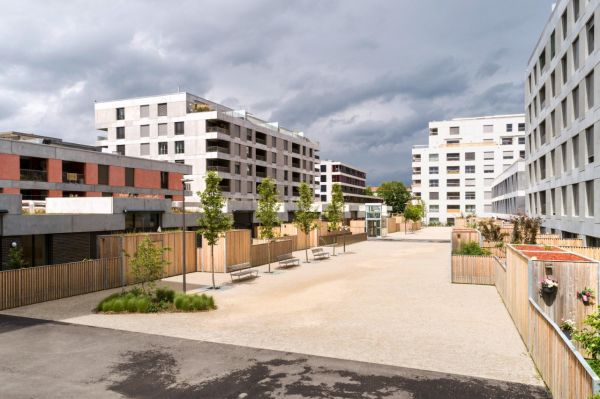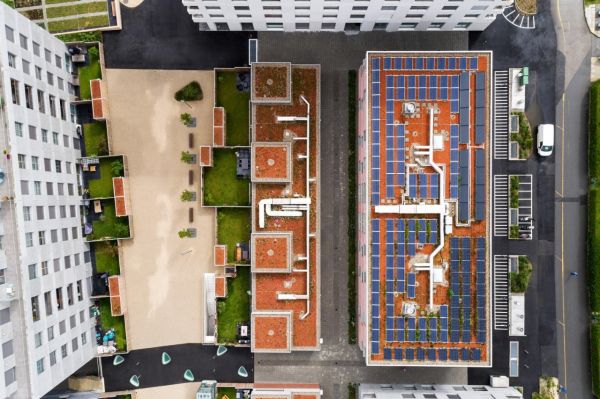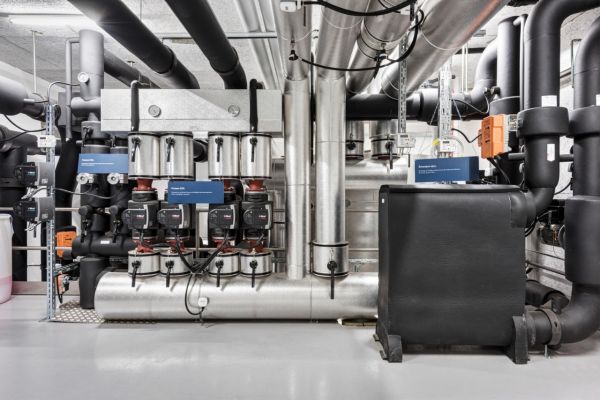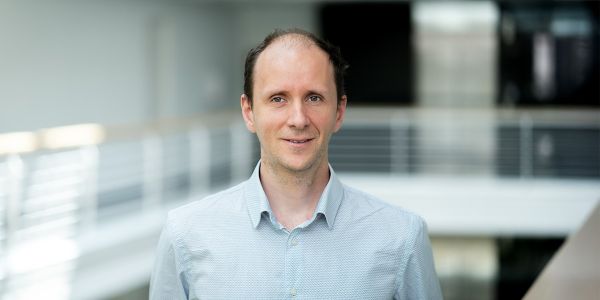- 2,300 MWh of heat required per year
- 190 MWh of cooling required per year
- CO₂ savings of 400 tonnes per year
With 900 new residents in 395 apartments, ‘Les Jardins du Couchant’ is a new district in the canton of Vaud. The new district includes both rental and owner-occupied apartments. The complex also offers subsidised housing and apartments for the elderly. The site also includes office and commercial space, a fitness centre, a pharmacy and a crèche.
Sustainable energy concept
The energy concept, which consistently relies on renewable energy, is also groundbreaking. We not only handle the supply of energy, but also the operation of combined heat pumps or cooling machines, the thermal solar panels and the gas boiler for covering peak demand. The Canton of Vaud has already implemented the Model Cantonal Building Regulations in the Energy Sector (MuKEn 2014). The solution we developed in collaboration with Conti & Associés Ingénieurs supports this requirement. The heat supply consists of a local heating network that uses geothermal energy and the sun as energy sources. This network supplies twelve buildings in four out of a total of five sectors.

80 per cent carbon-free heating
Two areas of geothermal probes extract heat from the ground, using a total of 58 geothermal probes at a depth of 250 metres, and deliver it to the heat pump. In the winter months, this heat is used for heating spaces and water. While the heating is generated centrally, the hot water production takes place decentrally at eight substations, each of which is equipped with its own heat pump and a thermal solar panel installation. This solution is more efficient and cost-effective compared to a purely decentralised solution, where each building is equipped with its own heating system. With this sustainable and environmentally friendly energy concept, more than 80 per cent of the heat supply at ‘Les Jardins du Couchant’ can be covered by renewable and carbon-free energy sources. More than 400 tonnes of CO2 can be saved per year in comparison to a purely fossil fuel supply.

Gentle cooling
In the summer months, the geothermal probes can also be used for cooling. Some of the commercial spaces and apartments can be cooled using free cooling, where excess heat from the rooms is fed back into the ground. This gentle and passive type of building cooling lowers the indoor temperature by 2 to 3 °C. Only the control system and circulation pump are in operation, the heat pump remains switched off. In hot spells with longer-lasting high temperatures, this is not enough. The heat pumps in the commercial areas are therefore technically equipped so that they also have the option of active cooling. In this case, the compressor remains in operation, which allows a higher cooling performance to be achieved.
However, this cooling not only has the advantage of reducing the indoor temperature, but also simultaneously regenerates the subsoil. The heat drawn from the rooms is returned to the heat source. This summer injection of excess heat into the subsoil is a good solution for counteracting the longer-term cooling of the soil.

Optimisation through monitoring
We also initiated a monitoring system with the commissioning of the heat supply. All figures for heating and cooling energy, for temperatures in the supply grid and for the electricity requirements for heat pumps and auxiliary units are recorded on an ongoing basis. Based on this data, the actual consumption can be compared with the planned values. Complex building services like these need to be adjusted during the first few months of operation, as it’s not possible to predict every situation that may arise. Based on the recorded values, our specialist teams have already been able to optimise the operation of the hot water production and thus continue to ensure optimal energy efficiency.
Investors:
- Fond de Prévoyance de CA Indosuez (Switzerland) SA
- Logement Social Romand SA
- Swiss Mobiliar Insurance Company Ltd.
- Caisse Inter-Entreprises de Prévoyance Professionnelle (CIEPP)






